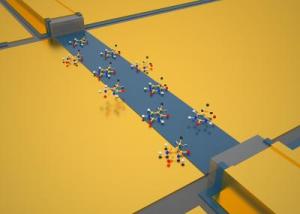Jun 13 2014
Using miniaturized laser technology, a tiny sensor has been built at the Vienna University of Technology which can test the chemical composition of liquids
 The light is emitted by the laser (top), transported on the plasmonic waveguide (blue) and hits the detector (bottom right). How much of it is absorbed depends on the chemical composition of the liquid. Credit: TU Vienna
The light is emitted by the laser (top), transported on the plasmonic waveguide (blue) and hits the detector (bottom right). How much of it is absorbed depends on the chemical composition of the liquid. Credit: TU Vienna
They are invisible, but perfectly suited for analysing liquids and gases; infrared laser beams are absorbed differently by different molecules. This effect can for instance be used to measure the oxygen concentration in blood. At the Vienna University of Technology, this technique has now been miniaturized and implemented in the prototype for a new kind of sensor.
Specially designed quantum cascade lasers and light detectors are created by the same production process. The gap between laser and detector is only 50 micrometres. It is bridged by a plasmonic waveguide made of gold and silicon nitride. This new approach allows for the simple and cheap production of tiny sensors for many different applications.
Laser and Detector
Simple solid-state lasers, such as the well-known red ruby laser, consist of only one material. Quantum cascade lasers, on the other hand, are made of a perfectly optimized layer system of different materials. That way, the properties such as the wavelength of the laser can be tuned. When a voltage is applied to the layer structure, the laser starts to emit light. But the structure can also work the other way around; when it is irradiated with light, an electric signal is created.
Now a method has been developed to create a laser and a detector at the same time, on one single chip, in such a way that the wavelength of the laser perfectly matches the wavelength to which the detector is sensitive. This bifunctional material was created atomic layer for atomic layer at the center for micro- and nanostructures at the Vienna University of Technology. "As both parts are created in one step, laser and detector do not have to be adjusted. They are already perfectly aligned", says Benedikt Schwarz.
Leading the Light to the Detector
In conventional systems, the laser light has to be transmitted to the detector using carefully placed lenses. Alternatively, optical fibres can be used, but they usually transport all the light inside, without letting it interact with the environment, and therefore they cannot be used as sensors.
In the new element created at the Vienna University of Technology, the optical connection between quantum cascade laser and detector works in a completely different way. It is a plasmonic waveguide, made of gold and silicon oxide. "The light interacts with the electrons in the metal in a very special way, so that the light is guided outside the gold surface", says Benedikt Schwarz. "That is why the light can be absorbed by the molecules on its way between laser and detector."
The sensor chip can be submerged in a liquid. By measuring the decrease of the detected light intensity due to the presence of light absorbing molecules, the composition of the liquid can be determined. The sensor was tested with a mixture of water and alcohol. The water concentration can be measured with an accuracy of 0.06%.
As the wavelength can be influenced by changing the design of the layered structure, this sensor concept can be applied to a wide variety of molecules such as carbohydrates or proteins, for many different applications in chemical, biological or medical analytics.
This news release is available in German.